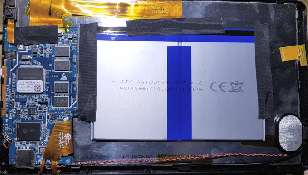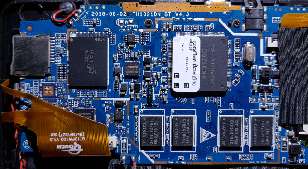Rick's b.log - 2019/06/10
You are 13.59.122.162, pleased to meet you!
Rick's b.log - 2019/06/10 |
|
| It is the 2nd of May 2024 You are 13.59.122.162, pleased to meet you! |
|
mailto: blog -at- heyrick -dot- eu
All it took was to have a nice bowl of beans on toast, using a throwaway plastic bowl because it's a weekend and I'm just that lazy. A pair of scissors later, and I had a piece of rigid plastic about an inch wide and and inch and a half long (say 2cm by 4cm). I carefully worked this in between the plastic pieces of the casing, and then just slid it in a circle around the casing. Each of the plastic catches, when encountered, would pop open. That done, it was a simple job to carefully lift the back off of the tablet, and collect the two plastic buttons that fell out.
Upon first glance, we can see that there isn't really much in here. The bulk of the device is the large screen. Stuck to the back of that is the flat battery pack which, as we can clearly see, is 4000mAh - less than half of the capacity that Android seems to think it is. The battery level measurement seems to be accurate enough, so I wonder why it thinks there's a 9000mAh battery attached? At least, that explains why it doesn't have a long lifespan. The full specs are 4000mAh, 14.8Wh, 3.7V.
Here is the circuit board:
For a guided tour, the far left is a slot for MicroSD cards. This correlates to the bottom right of the device when in use. The little thing with the black and red wires is an elecret microphone. The big black lump below that appears to be a generic 16GiB NAND flash. It looks like it uses a multiplex 8 bit data bus to transfer address, commands, and memory contents.
Working back along the bottom row now, four 2Gbit DDR3 SDRAM devices, giving a total of 1GiB memory. The SoC is capable of 800MHz operation, meaning the memory is theoretically capable of 1600Mb/sec/pin (though it doesn't feel like it!) as the device is capable of clocking data on each clock transition.
Klipad KL6889 tablet - an inside view
I noticed that the Klipad tablet did not have any screws. It appeared to be clipped together. So I guess what happened next was inevitable...

And on the side here (left in the photo, right in reality), the circuit board. Pretty small, but we must remember that we routinely get more into smaller spaces these days - mobile phones.
To the other side is a small speaker, and a comically naff WiFi antenna. It's a piece of printed cable with the antenna cable soldered to it. It does, honestly, amaze me that such things actually work.

Moving to the left, the tiny Rockchip IC is an RK816 which is a power management PMIC for use with LiPo cells, 5V USB supplies, and can work in reverse to provide 5V from the 3.7V cell. This is useful for supporting OTG functions on the USB port. Also included is an RTC.
The big chip is the heart of the device. An RK3126C SoC offering four Cortex-A7 cores, Neon (per core), VFP (per core), 32KiB/32KiB L1 cache (per core), and a shared 256KiB L2 cache. Graphical support is handled by a Mali400 MP2 GPU. Supports DDR3 SDRAM up to 2GiB (max), eMMC, SD, and all the usual sorts of timers and ports.
Beyond that is a 24MHz crystal from which system timing is derived. Above, the standard 3.5mm headphone jack, and to the right, a ribbon cable connection to the two cameras (using IIC?), and beyond that a larger ribbon cable for the display panel.
The tiny device to the left of the memory is a switched capacitor voltage converter, that basically takes an input voltage (in the range of 1.5 to 10V) and creates a negative form of it (-1.5 to -10V). As an aside, you will notice markings on the board that seem like a boundary around the major components. Quite possibly the outline of where a metal RF shield would be fitted, if this was a better quality device.
The ribbon cable here is to the touch sensor system, and to that end a GSL3680 capacitive touchscreen controller is present. It appears to communicate via IIC (with an interrupt pin), and has sixteen X outputs and eighteen Y inputs. It may be capable of tracking up to ten individual inputs at the same time. Beyond that I cannot say, the datasheet is written in Chinese.
There is one further device underneath the ribbon cable. Perhaps some sort of display driver chip or backlight control? I didn't want to mess with the fragile looking ribbon cable to work out that that device was, neither did I dismount the board to look at the other side. This tablet works, and I'd like to keep it that way thanks. ☺
David Pilling, 12th June 2019, 03:08 Rick, 14th June 2019, 18:31
Once upon a time, they said that about steam engines.
| © 2019 Rick Murray |
This web page is licenced for your personal, private, non-commercial use only. No automated processing by advertising systems is permitted. RIPA notice: No consent is given for interception of page transmission. |